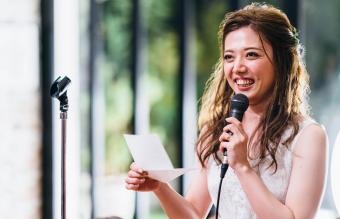
An outline for a wedding ceremony offers couples a sense of confidence. There are many variations couples can adopt or simply select a traditional ceremony, such as Christian, Jewish or Buddhist. If going with a non-traditional wedding, bridal couples can use an outline to plan their ceremony.
Outline of a Wedding Ceremony
Processional
The first part of any ceremony involves the wedding processional. A processional simply means how the wedding party arrives at the altar. In a church wedding, the wedding guests are seated by ushers, with the bride's guests on the left side of the aisle and the groom's guests on the right side of the aisle. Once all of the guests are seated, the mother of groom is escorted and seated in the front row on the right side. The father of the groom will follow behind the mother of the groom and usher. If the father is also the best man or one of the groomsmen, he stands at the front of the church with the groom. The mother of the bride is then escorted by an usher and seated in the front row on the left side. The grandparents of the bride and groom may also be seated in the same manner one row back from the mothers. In some wedding ceremonies, the groom escorts the parents and grandparents down the aisle before taking his place at the front of the ceremony site.The groom and minister should be at the front of the church or site when the rest of the wedding party processes. Each bridesmaid should be escorted by a groomsman and as they get to the front of the church, the groomsman should stand beside the groom and the bridesmaid should stand to in front of the bride's side of the church. After all of the bridesmaids and groomsmen have arrived, the flower girl and ring bear should slowly walk together to the front of the church and take their places beside the others in the wedding party. The bride will then be escorted by her father to the front while all of the guests stand for her processional.
Greeting
The minister or ceremony officiate will then greet the guests and ask them to sit. He will explain that the guests are present to witness the marriage of the bridal couple and ask the father of the bride to declare he is giving his daughter in marriage. At this point, the bridal couple typically links hands and the father of the bride will return to his seat beside the bride's mother. In modern or non-religious ceremonies, this aspect may be skipped.An invocation, or blessing, is given at a religious ceremony. A wedding reading may be used in a religious or non-religious ceremony at this time, also. There may be a musical interlude where a singer or other musician performs a song or hymn. At the conclusion, the minister will then provide a short speech on the importance of marriage and love.
Vows
The marriage vows, which are the center of the ceremony, come next. During the vows, the minister asks both the bride and the groom a series of questions designed to allow each to profess their lifelong commitment to the other. During this part of the ceremony, rings are also exchanged to symbolize unending love. At the conclusion of the vows, the minister will say a prayer or give a blessing to the newlyweds. The minister will pronounce the couple are now husband and wife and state, "You may now kiss the bride."In a Buddhist ceremony, the vows are exchanged following the opening prayer. The main difference in a Buddhist ceremony from a Christian or Jewish one is that the vows are spoken together. Instead of the bride professing then the groom following, the couple commits to love and commitment to their spouse, but also to living a Buddhist lifestyle.
In a Jewish ceremony, the vows are followed by a wine ritual which includes the bride and groom drinking from the same cup as a symbol of their new life together being both bitter and sweet. During a Jewish ceremony, there is also a silent prayer after the blessing in which the congregation is charged with praying for the new couple's many blessings.
Recessional
After the couple kisses in a Christian ceremony, they will turn to face the guests and as the minister presents them as husband and wife they recess down the main aisle. In a Jewish ceremony, however, the groom is handed a bottle, which is typically wrapped in a towel. The groom lays the bottle on the floor and smashes it with his foot. The breaking glass is intended to symbolize how fragile marriage is, and that the bride and groom need to take care of the covenant. It represents the idea that just as the shattered pieces cannot be put back together, the vows taken are a permanent act and should last forever.
After the bride and groom reach the back of the church, the flower girl and ringer bearer follow. The bridesmaids and groomsmen follow them and then an usher returns to escort the parents and grandparents. Once the family has been ushered out of the church, the remaining guests follow by row until the church is emptied.
Make It Your Own
Whether you use a traditional wedding ceremony outline or choose something completely your own, the important thing to remember is that the vows are what should be most meaningful. How you arrive or depart the church and the order of the music should be a secondary aspect to the words and commitment you share with your spouse. Simply enjoy the process and the day will be one to treasure.







